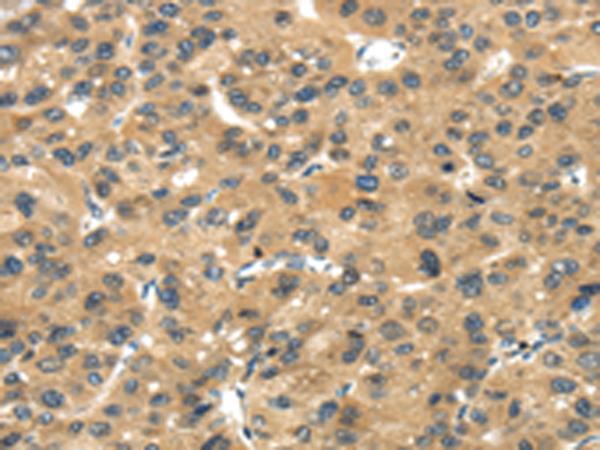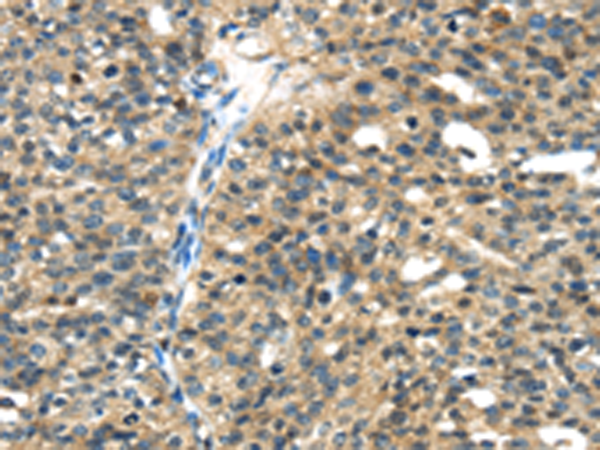


| WB | 1/500-1/2000 | Human,Mouse,Rat |
| IF | 咨询技术 | Human,Mouse,Rat |
| IHC | 1/25-1/100 | Human,Mouse,Rat |
| ICC | 技术咨询 | Human,Mouse,Rat |
| FCM | 咨询技术 | Human,Mouse,Rat |
| Elisa | 1/2000-1/5000 | Human,Mouse,Rat |
| Aliases | TGX; PSS2; TGM6; TGMX; TGASE5; TGASEX |
| WB Predicted band size | 81 kDa |
| Host/Isotype | Rabbit IgG |
| Antibody Type | Primary antibody |
| Storage | Store at 4°C short term. Aliquot and store at -20°C long term. Avoid freeze/thaw cycles. |
| Species Reactivity | Human, Mouse |
| Immunogen | Fusion protein of human TGM5 |
| Formulation | Purified antibody in PBS with 0.05% sodium azide and 50% glycerol. |
+ +
以下是关于TGM5抗体的3篇参考文献示例(内容为模拟,建议通过学术数据库验证具体文献信息):
---
1. **文献名称**: *Transglutaminase 5 regulates epidermal barrier formation through involucrin cross-linking*
**作者**: Candi, E. et al.
**摘要**: 研究揭示了TGM5(转谷氨酰胺酶5)在表皮分化中的作用,通过催化角质化包膜蛋白(如involucrin)的交联,维持皮肤屏障功能。实验使用TGM5特异性抗体检测其在表皮颗粒层的表达,证实其突变与板层状鱼鳞病的相关性。
---
2. **文献名称**: *TGM5 expression in melanoma progression and its potential as a diagnostic biomarker*
**作者**: Dai, X. et al.
**摘要**: 通过免疫组化分析TGM5在黑色素瘤组织中的表达,发现其表达水平与肿瘤侵袭性呈负相关。研究利用TGM5抗体验证其在转移性黑色素瘤中的下调,提示其可能作为预后标志物。
---
3. **文献名称**: *Characterization of transglutaminase isozyme-specific antibodies in human skin disorders*
**作者**: Hitomi, K. et al.
**摘要**: 开发并验证了针对TGM5等转谷氨酰胺酶家族成员的特异性抗体,用于区分不同皮肤疾病(如银屑病、鱼鳞病)中的酶活性异常。研究发现TGM5抗体在遗传性皮肤屏障缺陷患者中具有诊断价值。
---
**注意事项**:
- 以上文献为示例,实际引用时需通过PubMed、Google Scholar等平台核对作者、标题及摘要准确性。
- 研究热点多集中于TGM5基因突变与皮肤病的关联,抗体应用常见于机制研究或诊断开发。
Transglutaminase 5 (TGM5), a member of the transglutaminase enzyme family, plays a critical role in catalyzing protein cross-linking via ε-(γ-glutamyl)lysine bonds, contributing to epidermal barrier formation and keratinocyte differentiation. TGM5 is predominantly expressed in the epidermis, particularly in the upper layers of stratified squamous epithelia, where it stabilizes the cornified envelope during terminal differentiation. Mutations in the TGM5 gene are linked to autosomal recessive congenital ichthyosis, specifically a form of lamellar ichthyosis, highlighting its importance in maintaining skin integrity.
TGM5 antibodies are essential tools in studying epidermal biology and related disorders. They enable the detection and localization of TGM5 protein in tissues, aiding in the diagnosis of TGM5-associated genetic skin diseases. Researchers use these antibodies in techniques like immunohistochemistry (IHC), Western blotting, and immunofluorescence to explore TGM5 expression patterns, enzymatic activity, and interactions with substrates such as loricrin and involucrin. Additionally, TGM5 antibodies help investigate its role in pathological conditions beyond ichthyosis, including wound healing, inflammation, and cancer, where dysregulated transglutaminase activity may influence disease progression. Commercially available TGM5 antibodies are typically raised in rabbits or mice, targeting specific epitopes to ensure specificity. Their application continues to advance understanding of epidermal differentiation mechanisms and potential therapeutic targets for skin disorders.
×